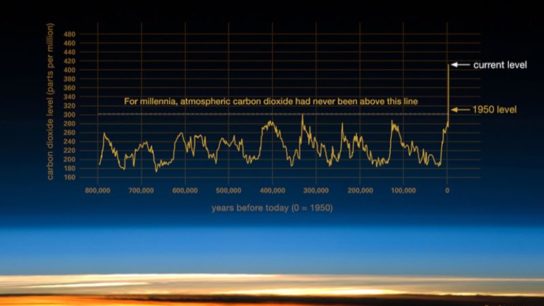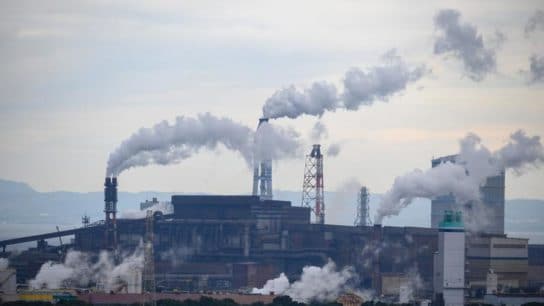Qatar and Bahrain, both found on the Persian Gulf, are extremely vulnerable to sea level rise. The bulk of their populations and commercial activities are stacked on their shorelines, and little effort has been expended to adapt to a rapidly changing environment.
Earth.Org takes a closer look.
—
The Kingdom of Bahrain consists of 40 islands with a small overall area of 767 km² and one of the highest population densities in the world at 1,700 persons per km². Most of its activity and population is concentrated on coastal areas that do not exceed 5 m elevation above sea level, and the highest point is only 134m high. As climate change progresses, more frequent and intense droughts are predicted to afflict Bahrain, but its greatest challenge is the slow advance of sea level rise.
Based on the Intergovernmental Panel on Climate Change’s predictions, 1.5 m of sea level rise would submerge 27% of the Kingdom’s land area. This puts its urban, industrial, recreational and critical infrastructures at risk and forces decision-makers to design a comprehensive adaptation plan if they are to avoid insurmountable economic losses.
Qatar is in a similar situation. It is experiencing rapid demographic growth in its mainly coastal urban areas, including its capital city Doha. The city’s most important political and economic sectors (West Bay, Al Corniche and Al Dafna) are all located on the shoreline, which makes sea level rise an extremely expensive problem. While storm surge and flash floods are rare here, over 18% of Qatar’s land area is low enough to be permanently reclaimed if the oceans rise 5m above pre-industrial levels.
Both Bahrain and Qatar are facing economic challenges for the long run, as they must generate employment for its exploding young, educated population. A heavy dependence on few commodities like oil has made national budgets unstable, making it difficult to implement and stay committed to long-term plans. Unfortunately, sea level rise is a challenge that will span decades, and progressive yet steady work will be key to mitigating its effects. The UN provides many avenues to help fund and execute adaptation strategies, and these have historically been under-used by Arab countries. The onus is on them to begin reaching out and committing their thoughts, time and money to solving a problem that cares little for political and economical issues.

Sea level rise projections by 2100 for two scenarios with the amount of rise in meters indicated (mild = 1m; extreme = 3m). Population displacement indicated bottom right.
Sea Level Rise Methodology
Global mean sea level is projected to rise by 2m at the end of this century. However, in order to determine local sea level rise (SLR), one has to take into account local coastal flood levels which could be 2.8m above Mean Higher-High Water (MHHW) at extreme forecasts. These local levels bring variability to the projected SLR from 1m to 6.5m (eg. Rio vs Kolkata).
The SLR scenarios used in this study are based on the forecasts from Climate Central – Coastal Risk Screening Tool with the following parameters:
- Sea level Projection Source
- Coastal Flood Level
- Pollution Scenario
- Luck
Sea level Projection Source:
From two highly cited journals by Kopp et al., estimating SLR mainly due to ocean thermal expansion and ice melt. The mid-range scenario projected 0.5-1.2m of SLR based on different representative concentration pathways (RCP) defined by the IPCC. While the pessimistic scenario added more mechanisms of ice-sheet melting, estimating SLR at 1m-2.5m in 2100, with a projection of 10m SLR at 2300.
Coastal Flooding
More frequent coastal flooding is a direct impact of sea-level rise. Based on the Global tides and surge reanalysis by Muis et al., (2016), it is estimated that the extreme coastal water level could be from 0.2 – 2.8m over the mean level. While in extreme cases like China and the Netherlands it could experience 5-10m of extreme sea levels. Here, the coastal local flood level is added on top of the projected SLR.
Pollution Scenario:
Allows choosing the RCP, the greenhouse gas concentration trajectory defined by the IPCC. The mild level is based on RCP4.5, of 2°C temperature rise; while the Extreme level is based on RCP 8.5, of 4°C temperature rise.
Luck:
Applies to the baseline SLR, defined in the “Sea level projection” section, upon which we add flooding. “Mild” refers to the mid-range scenario of 0.5-1.2m, and “extreme” to the pessimistic scenario of 1-2.5m. We used the high-end value of each scenario (mild = 1m; extreme = 2.5m).
You might also like: Sea Level Rise by 2100 – The Persian Gulf
References:
-
Kulp, Scott A., and Benjamin H. Strauss. “New elevation data triple estimates of global vulnerability to sea-level rise and coastal flooding.” Nature communications 10.1 (2019): 1-12.
-
Florczyk, A. J., Corbane, C., Ehrlich, D., Freire, S., Kemper, T., Maffenini, L., Melchiorri, M., Politis, P., Schiavina, M., Sabo, F. & Zanchetta, L. (2019). GHSL Data Package 2019 Public Release.
-
Kopp, R. E., DeConto, R. M., Bader, D. A., Hay, C. C., Horton, R. M., Kulp, S., Oppenheimer, M., Pollard, D. & Strauss, B. H. (2017). Evolving Understanding of Antarctic Ice-Sheet Physics and Ambiguity in Probabilistic Sea-Level Projections. Earth’s Future, 5(12), 1217–1233.
-
Kopp, R. E., Horton, R. M., Little, C. M., Mitrovica, J. X., Oppenheimer, M., Rasmussen, D. J., Strauss, B. H. & Tebaldi, C. (2014). Probabilistic 21st and 22nd Century Sea-Level Projections at a Global Network of Tide-Gauge Sites. Earth’s Future, 2(8), 383–406.
-
Kulp, S. A. & Strauss, B. H. (2019). New Elevation Data Triple Estimates of Global Vulnerability to Sea-Level Rise and Coastal Flooding. Nature Communications, 10(1), 4844. Retrieved June 21, 2020, from http://www.nature.com/articles/s41467-019-12808-z
-
Muis, S., Verlaan, M., Winsemius, H. C., Aerts, J. C. J. H. & Ward, P. J. (2016). A Global Reanalysis of Storm Surges and Extreme Sea Levels. Nature Communications, 7.
-
Laurent A. Lambert, Cristina D’Alessandro (2019). Climate Change, Sea Level Rise, and Sustainable Urban Adaptation in Arab Coastal Cities. Middle East Institute.










![The Statistics of Biodiversity Loss [2020 WWF Report]](https://u4d2z7k9.rocketcdn.me/wp-content/uploads/2020/12/lprwinkyTHB-544x306.jpg)





